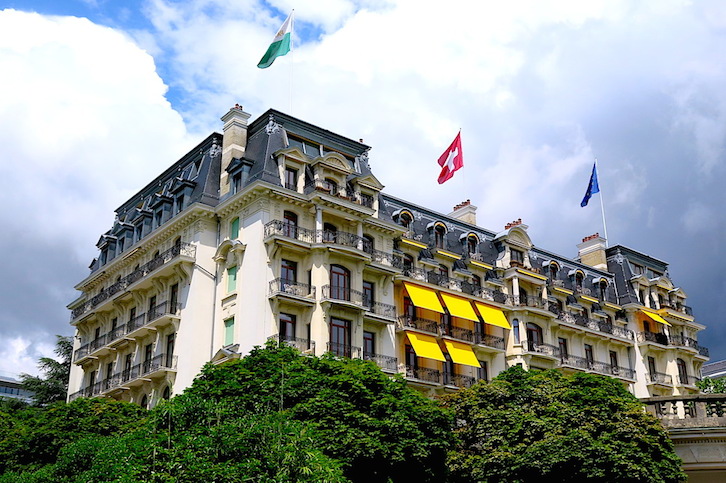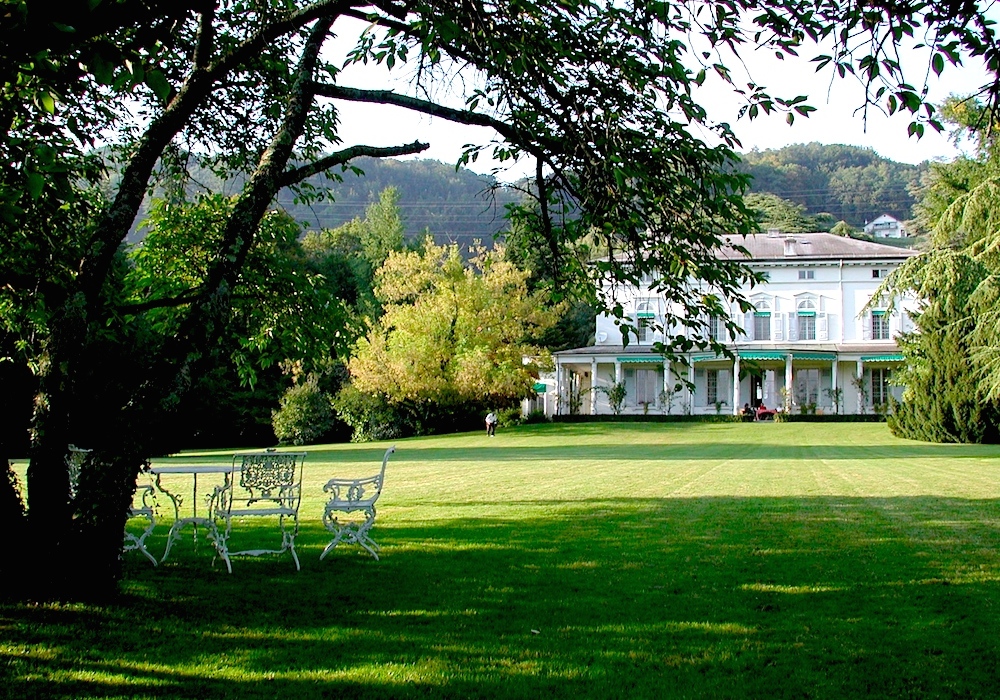Elevating hospitality to a five-star art has been a specialty of Switzerland since the founding in 1893 of the world’s first hotel school, École hôtelière de Lausanne, located in the Lake Geneva Region in the French-speaking part of the country.
With nearly 1500 lakes and 140 glaciers, as well as snow-capped mountains and a surfeit of luxury accommodations, Switzerland has a history of hosting the world’s most illustrious and celebrated citizens.
Adopted by the European aristocracy, Montreux became an international resort thanks in part to the works of Jean-Jacques Rousseau and Lord Byron, both of whom rhapsodized about the idyllic locale. Since the mid 19th-century, Switzerland’s Riviera has attracted long-term guests and residents such as Empress Elisabeth of Austria (known as “Sissi”), Lord Byron, Mary and Percy Shelley, Victor Hugo, Henry James, Coco Chanel, Marlene Dietrich, Charlie Chaplin, Vladimir Nabokov, Mahatma Gandhi, and Prince. In the words of the late great Freddie Mercury, “If you want peace of mind, come to Montreux.”
As the home of the annual Montreux Jazz Festival, Montreux has hosted nearly every legendary musical performer since the festival’s inception by Claude Nobs in 1967. Akin to a Champagne-infused Woodstock, the two-week party honors its historic pedigree with a roster of international talent that plays all through the nights to a crowd that is as comfortable in Dior as in jeans and espadrilles.
For sixty years, from 1897 through 1957, the Montreux Narcissus Festival attracted visitors to the annual “May snow” of wild narcissus blooms that proliferate on the meadows above Montreux and Vevey. Now, after a lengthy hiatus, the Montreux Narcissus Festival will resume again with a citywide festival that includes processions of floral floats and the crowning of a narcissus queen, as well as a gala evening. For those seeking total floral immersion, pathways traverse the fields of flowers just above Montreux.
The most visited monument in all of Switzerland is Chillon Castle, the medieval castle located just outside Montreux on a small rocky island on the shores of Lake Leman (aka Lake Geneva), which has been used since the 12th century as a fortress, an arsenal, and, most famously, as a prison for a man named Bonivard, who became the hero of Byron’s “The Prisoner of Chillon.” Artists such as Rousseau and Hugo, as well as Eugene Delacroix and Gustave Courbet, all took inspiration from the picturesque chateau.
The spirit of Byron lingers at the luxurious 18th-century Hôtel Angleterre & Residence where the poet took up residence during the composition of his legendary ode in 1816. This summer, Lausanne welcomes the rebirth of another historic hotel with the reopening of the legendary Hotel Royal Savoy. Located in the heart of Lausanne, the palatial Art Nouveau hotel was a favorite of royals when it opened in 1906. The recent $100 million renovation and expansion of the five-star property retains the historic façade while offering modern interiors and a new rooftop Sky Terrace with panoramic views.

Lausanne’s interactive Olympic Museum captures some of that Olympic ebullience with its cheerful crowds who spill out onto the Olympic Park. ©MRNY
According to Pierre Coubertin, the French-born visionary who revived the Olympic games in 1896, “the first prerequisite is to be joyful” in order to achieve Olympic success. Lausanne’s interactive Olympic Museum captures some of that Olympic ebullience with its cheerful crowds who spill out onto the Olympic Park, an extension of the museum that features works of contemporary artists, statues, a fountain, an amphitheater, and the Olympic fire, as well as a running track.
High on a hill overlooking Lausanne, housed in a 19th-century banker’s residence, Fondation de l’Hermitage is devoted to temporary exhibitions of fine arts. A brasserie-style restaurant, l’Esquisse, is located in the former dovecote that flanked the orangery. Surrounded by English gardens and a private park planted with a variety of rare trees, the estate overlooks Lausanne’s 13th-century Gothic cathedral and Lake Geneva—a vista that so mesmerized Camille Corot that he painted the landscape in 1825.

The Lavaux wine region is home to Au Clos de la République, the 84-acre estate of Patrick Fonjallaz, a 12th-generation winemaker ©MRNY
Designated a UNESCO World Heritage site in 2007, the Lavaux wine region is home to Au Clos de la République, the 84-acre estate of Patrick Fonjallaz, a 12th-generation winemaker whose family has cultivated grapes since 1552. As for the wine, it’s so divine that the Swiss all but refuse to export it, choosing to imbibe it themselves.
In the spring of 2016, Charlie Chaplin fans from around the world will celebrate the opening of The Modern Times Museum located in Chaplin’s erstwhile mansion in Corsier-sur-Vevey where he lived from 1957 to 1977. Surrounded by 34 acres of gardens, pathways, and terraces with panoramic views of Lake Geneva and the Alps, the museum is dedicated to the life and times of the filmmaker and actor and offers more than 32,000 square feet of interactive exhibition space.
A complement to the museum, the new four-star Moderntimes Hotel opens in autumn 2015 in nearby Saint-Légier-La Chiésaz with 145 rooms, fitness room, bar, and shuttle bus service to the museum.
And what is Switzerland without chocolate? In honor of Chaplin, Lausanne chocolatier Tristan Carbonatto has created an edible “Little Tramp” inspired by Chaplin’s onscreen alter ego.
A little wine and chocolate before noon? Why not, you’re celebrating life in the Lake Geneva Region, a land of empyrean beauty.





























